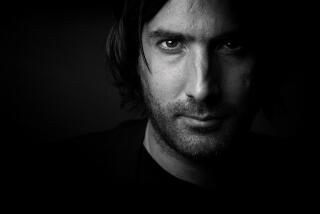FIFTY YEARS OF EUROPE An Album By Jan Morris, Villard: 364 pp., $24
- Share via
Find the right spot as fulcrum for your lever, Archimedes said, and you can pry up the world. In another large prying venture--this one seeking to lever up the meaning of Europe’s past and present--Jan Morris sets her fulcrum upon a bollard in the port of Trieste.
Why Trieste? Because, during the centuries that it was the Mediterranean outlet for the Austro-Hungarian empire (it went to Italy only after World War I), it was a teeming retort of Germans, Italians, Slavs, Magyars, French, British and any number of others: part entrepot and part pot-au-feu. For some years the French honorary consul, also director of the Trieste Opera, bore the name and title of Baron Rafaelle Douglas de Banfield-Tripcovich.
It was, if you like--and Morris likes--the vividly lowdown precursor, writ small, of today’s high-minded, bland and still undefined European Community.
Why the bollard? In part because it stands on the Audace Pier, named for the warship that arrived in 1918 to raise Italy’s flag. An Italian ship, of course--that is, it was built in Scotland for Japan and then, when Italy came in on the Allied side in 1916, the British turned it over to Italy, only to sink it in 1939 when Mussolini switched and came in with the Germans.
A truly European story, Morris reflects from her bollard. She had traveled all the way from her home in Wales so that she could sit upon it and site her introduction. For Morris, all writing grows out of a sense of place. Never mind cyberspace: If you are a journalist, you go there.
Morris has been turning out accomplished books and journalism for 50 years (formerly, before a sex change, as James Morris). It was a half-century of crisscrossing the world, particularly Europe, visiting and revisiting people, places and things, both famous and obscure. One imagines the carved owl on a Dijon wall and a particular Bucharest lamp post (both appear here) perking up at her approach. “Here comes Jan again, and we are to be mentioned.”
The subtitle of “Fifty Years of Europe” is “An Album.” To the degree that it is one, it is pungent and provocative. There is a suggestion that it would like to be more.
The more could be rendered by a question: Why, when all the histories, particularities, achievements and catastrophes of Europe make such a fascinating if often horrifying tapestry, do efforts to write about the post-Cold War present seem so flat? Why is a headline about the European parliament such a page-turner, and not in the book sense?
Surely there must be a way to link the resonances of Charlemagne, the Renaissance, Goethe, Beethoven, Bismarck, Voltaire, Queen Victoria, the French paysan, the Scottish crofter and the Spanish Civil War to Europe’s Common Market and suburban supermarkets. Morris doesn’t manage it nor, to be fair, does she try very hard.
Most of “Fifty Years of Europe” is a series of brief sketches, vignettes and observations, sorted in very large and approximate thematic baskets. These may serve the convenience of the writer more than the reader. More fox than hedgehog, Morris is at her best when a theme lurks ghostlike, haunting a scene’s particulars.
*
Some of the baskets seem to be filled by shopping lists. One, dealing with Europe’s connections, includes wearisomely tiny accounts of bridges, tunnels and ferries. Others are like a basket you bring to the seashore, fill with shells and take home holding a whole ocean kingdom.
The first one, “Holy Symptoms,” may be the most suggestive. It is a collection of things that Europeans have cherished for belief, whether religious, magical or superstitious. We get brief glimpses of megalithic shrines and a 1,000-year-old horn dug from a Danish bog. Played on ceremonial occasions, it produces “the oldest sound in Europe.”
Morris finds her own stones near her home in Wales (once proudly British, these days she calls herself Euro-Welsh). Their magic is more modest; they are lichen-covered and “smell like donkeys.” All over Europe she finds dark bronze statues with a gleaming brassy finger or forehead: Dublin’s Cuchulain, Dresden’s Bacchus, Maestro Mateo at Santiago de Compostela, kissed or touched by generations of pilgrims, tourists and townsfolk.
She chats with the archbishop of Canterbury about toenail problems and reflects how much more potent--and unlikely--it would be to have a similar conversation with the pope. For a moment--those seashells, those ghosts--we have Europe’s Reformation and Counter-Reformation played out.
Another ghost, the resurgence of pre-communist ways in Central Europe, attends the menu of Gundel’s, Budapest’s celebrated and revived pre-war restaurant: Wild Suckling Pig Soup Flavored with Tarragon, Count Szechenyi’s Roast Breast of Pheasant Stuffed with Hungarian Goose Liver. Gundel’s, reads an endorsement by Otto of Habsburg, “shows Hungary on the way to a glorious revival.”
Morris’ album is drawn from 50 years of notebooks and at times, amid considerable padding, there is the effect of notebooks emptied out. Some of the traveling she does to bring her Europe up to date seems forced. In her account of a pilgrimage up Ireland’s holy Croagh Patrick mountain, there is a hint of an assigned--self-assigned, in this case--newspaper feature: Go have the experience so you can write about it. Not entirely, though. Morris takes faith seriously; Croagh Patrick moves her. True, for 50 years she has been traveling to write, but she has also been traveling to believe.
At the end, rather limp and disjointed, she wishes the new Europe well without concealing her unexcitement. The Palais de Berlaymont in Brussels, headquarters for the European community, carries lack of personality to the point of arrogance. She compares it regretfully to the ornate and spiky fantasy she discerns, for example, in the Parliament buildings in London and Budapest.
For what Morris has been seeking--the soul of Europe--her Triestine bollard does better than Berlaymont. It is a soul that lives in a clash of particulars, not a treaty of universals.
Also, it was on that same bollard that Morris, just out of the wartime British army in 1946, perched to attempt a very young essay entitled “Nostalgia.” Nostalgia haunts her vision still but never clouds it. In its best moments, her album displays years of sharp, present observation uniquely colored and elucidated by a sense of the past.
More to Read
Sign up for The Wild
We’ll help you find the best places to hike, bike and run, as well as the perfect silent spots for meditation and yoga.
You may occasionally receive promotional content from the Los Angeles Times.






